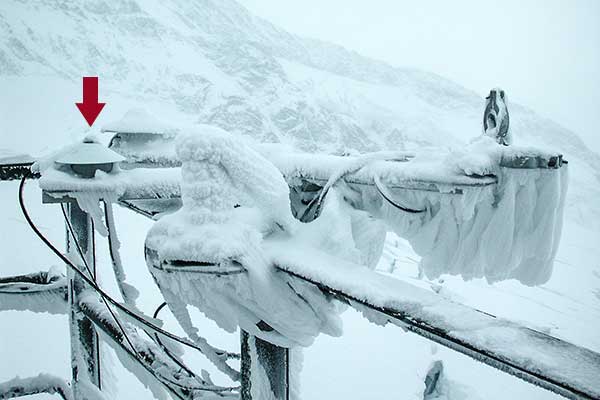
Climatic Challenges for Outdoor Optical Radiation Measurements
Instrumentation for measuring solar radiation is often subject to extreme climatic conditions as much research is necessarily located high in mountain areas or other hostile environments such as the Arctic and Antarctic regions. For example, the High Altitude Research Station, Jungfraujoch (HSFJG) [1] Switzerland is located 3456 m above sea level. It has been the location for solar radiation measurements with both broadband radiometers and spectroradiometers since the 1980’s. One research project undertaken during the months of October and November investigated whether the broadband device WPD-UVA-03 (Gigahertz-Optik GmbH) was suitable as a monitor detector for relatively slow scanning spectroradiometers such as the Bentham DTM300 double monochromator.
The broadband measuring device was exposed to very demanding weather conditions.
"The BfS at the Schneefernerhaus - measurement of UV radiation at an altitude of 2666 m"Read less
Air temperatures on the Jungfraujoch ranged from + 5 °C to -18 °C with wind speeds of up to 150km/h. In addition, the device had to withstand sporadic icing. Third party comparison work by CMS Schreder concluded that the UV-A broadband meter had sufficient stability even under extreme weather conditions. Thus, it was very well suited as a monitor detector for quality control of spectroradiometers used for global solar radiation. A suitable broadband monitor detector can be used to reduce the inherent measurement uncertainties resulting from the long measuring times of scanning spectroradiometers (typically 2 minutes or more) which are due to short-term events such as passing clouds.

Comparison of solar measurements with BTS2048-UV-S and a double monochromator.
Conventionally, double monochromator based scanning spectroradiometers have been used for solar UV measurements due to their high scattered light performance. In 2017, Gigahertz-Optik GmbH introduced the weatherproof UV spectroradiometer BTS2048-UV-S-WP [2] for outdoor solar radiation measurements. Its BiTecSensor provides the benefits of a fast, high-resolution array spectroradiometer, but with excellent scattered light rejection combined with the properties of a broadband detector. The weatherproof BTS2048-VL-TEC-WP spectroradiometer is also available for outdoor solar radiation measurements in the visible and near-IR wavelength regions (to 1050nm).
References